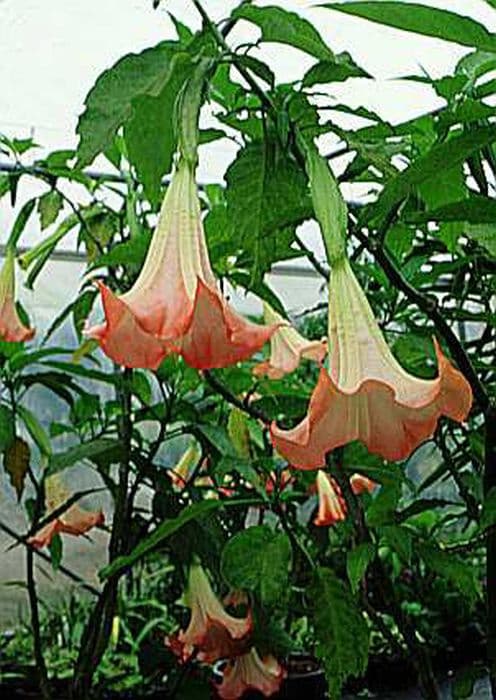Million Bells Calibrachoa Cabaret Deep Yellow = 'Balcabdepy' (PBR) (Cabaret Series)
![calibrachoa [Cabaret Deep Yellow]](/_next/image?url=https%3A%2F%2Fplants-admin.emdemapps.com%2Fimages%2Fplants%2F%2Fimages%2F604b5f20ca3ef.png&w=3840&q=75)
ABOUT
The Calibrachoa Cabaret Deep Yellow, commonly referred to as Million Bells, is a stunning plant boasting vibrant deep yellow blooms. The flowers are trumpet-shaped, creating a delightful display that adds cheer to any garden. The petals have a smooth and velvety texture that glistens in the sunlight. This variety, part of the Cabaret Series, impresses with its prolific flowering ability, presenting a dense coverage of blossoms that create a lush, colorful blanket. The leaves are small and green, providing a lovely contrast to the bright flowers. The growth habit is trailing, which makes the Million Bells ideal for hanging baskets, containers, or as a spilling plant over walls and edges. Its overall appearance is both eye-catching and elegant, with flowers that invite closer inspection. The plant continues to produce new blooms throughout the growing season, ensuring a long-lasting display. Overall, this plant is a charming selection for those desiring a pop of deep yellow color in their garden palette.
About this plant
 Names
NamesFamily
Solanaceae
Synonyms
Million Bells, Mini Petunia
Common names
Calibrachoa Cabaret Deep Yellow = 'Balcabdepy' (PBR) (Cabaret Series)
 Toxicity
ToxicityTo humans
The plant commonly known as Calibrachoa is generally considered non-toxic to humans. Therefore, ingestion is unlikely to cause any significant symptoms of poisoning or harm. However, as with any non-food plant, if large quantities are ingested it could potentially cause discomfort or an upset stomach due to the unusual material in the digestive tract. Always exercise caution and prevent children from ingesting parts of ornamental plants, as individual sensitivity could vary.
To pets
Calibrachoa, commonly referred to as mini petunia, is not known to be toxic to pets, such as cats and dogs. Ingestion of this plant should not lead to any serious symptoms of poisoning. However, ingestion of any plant material can potentially cause mild gastrointestinal upset in some pets, including symptoms like vomiting or diarrhea. If a pet ingests a large amount of the plant, or if any concerning symptoms are observed, it is advisable to contact a veterinarian.
 Characteristics
CharacteristicsLife cycle
Annuals
Foliage type
Evergreen
Color of leaves
Green
Flower color
Deep Yellow
Height
6-12 inches (15-30 cm)
Spread
12-24 inches (30-60 cm)
Plant type
Herb
Hardiness zones
9
Native area
South America
Benefits
 General Benefits
General Benefits- Easy to Grow: The plant is known for being easy to cultivate, requiring minimal maintenance, which is perfect for both novice and experienced gardeners.
- Vibrant Color: It produces deep yellow flowers that can brighten up any garden space or container.
- Continuous Blooming: This variety blooms prolifically from spring to frost, providing long-lasting color throughout the growing season.
- Attracts Pollinators: The bright flowers attract beneficial insects like bees and butterflies, aiding pollination in the garden.
- Drought Tolerant: Once established, it can tolerate periods of dryness, making it suitable for gardens in arid climates or for water-wise gardeners.
- Frost Resistance: As part of the Cabaret series, it shows a degree of resistance to cooler temperatures, which can extend its blooming period in the fall.
- Versatile Use: Ideal for use in containers, hanging baskets, window boxes, and as a groundcover, it offers flexibility in garden design and landscape use.
- Compact Growth: The plant maintains a neat, mounding habit, which is perfect for creating tidy, dense displays without overgrowing its allotted space.
 Medical Properties
Medical PropertiesThis plant is not used for medical purposes.
 Air-purifying Qualities
Air-purifying QualitiesThis plant is not specifically known for air purifying qualities.
 Other Uses
Other Uses- Ink Production: The vibrant petals of Calibrachoa can be boiled down to create a natural yellow dye for inks used in art and fabric printing.
- Photography Prop: The eye-catching Calibrachoa flowers can be used as a vivid prop or background in macro photography to capture stunning visuals.
- Culinary Decoration: Petals of the Calibrachoa can be used to add a splash of color to salads and desserts, though they should be used sparingly and only if confirmed non-toxic.
- Educational Tool: Calibrachoa plants can be used in schools to teach children about plant growth, reproduction, and pollination in hands-on gardening projects.
- Handmade Paper: Dried Calibrachoa petals can be incorporated into paper making to add texture and color to the finished product.
- Textile Patterns: The shape and color of Calibrachoa flowers can inspire designs and patterns for textiles and clothing.
- Color Therapy: The bright yellow color of Calibrachoa flowers can be used in color therapy sessions to evoke feelings of cheerfulness and vitality.
- Floating Decorations: Calibrachoa flowers can float in water bowls as a decorative element for garden parties or tranquil spaces.
- Floral Jewelry: The small size of Calibrachoa flowers makes them suitable for crafting into delicate floral jewelry, such as earrings or pendants.
- Biodegradable Confetti: Dried Calibrachoa petals can serve as an environmentally friendly alternative to traditional confetti at celebrations.
Interesting Facts
 Feng Shui
Feng ShuiThe Calibrachoa is not used in Feng Shui practice.
 Zodiac Sign Compitability
Zodiac Sign CompitabilityThe Calibrachoa is not used in astrology practice.
 Plant Symbolism
Plant Symbolism- Optimism: The vibrant deep yellow color of the Million Bells often symbolizes positivity and a bright outlook, representing the cheerfulness and joy that they bring to gardens.
- Celebration: As part of the Cabaret series, Million Bells are often associated with festivity and are used to beautify spaces during celebrations and special events.
- Creativity: The unique and abundant flowers of the Million Bells may signify creativity and inspiration, much like the diverse and imaginative arrangements they can inspire in gardeners and florists alike.
- Warmth: The warm deep yellow hue can represent friendship and warmth of feelings, evoking a sense of welcoming and comfort.
- Energy: Similar to the way they invigorate a garden space, Million Bells can symbolize energy and the power of the sun, bringing life and vibrancy wherever they are planted.
 Water
WaterThe Million Bells should be watered regularly, aiming to keep the soil evenly moist but not soggy. Depending on the climate, this may mean watering every few days or even daily during hot, dry periods. It is best to check the top inch of soil for dryness and water when it feels dry to the touch. Use a gentle water stream directly to the base of the plant, avoiding overhead watering to prevent disease. The amount needed will vary, but a guideline is to provide about 1 gallon of water per week, adjusted for rainfall and temperature.
 Light
LightFor the Million Bells, the best light conditions include full sun to partial shade, with at least 4-6 hours of sunlight each day. They thrive in bright, direct light, which helps promote abundant flowering. If grown indoors, a south-facing window is an ideal spot, while outdoors, they should be planted where they will receive ample sunlight throughout the day.
 Temperature
TemperatureMillion Bells prefer moderate temperatures and perform best when daytime temperatures range between 60 to 75 degrees Fahrenheit. They can tolerate minimum temperatures down to 35 degrees Fahrenheit and maximum temperatures around 90 degrees Fahrenheit, but extended periods outside this range can stress the plant.
 Pruning
PruningPruning Million Bells is essential to encourage bushier growth and more blooms. Pinch off the tips of the stems and remove any dead or faded flowers every few weeks. The best time to prune is in the early spring or when the plant starts to look leggy. Regular deadheading also promotes continuous blooming throughout the season.
 Cleaning
CleaningAs needed
 Soil
SoilMillion Bells prefer a well-draining potting mix with peat moss and perlite. A pH between 5.5 and 6.5 is best for optimal growth.
 Repotting
RepottingMillion Bells should be repotted annually to refresh the soil and encourage healthy growth, ideally in spring.
 Humidity & Misting
Humidity & MistingMillion Bells thrive in moderate to high humidity levels but are adaptable to average home humidity.
 Suitable locations
Suitable locationsIndoor
Place Million Bells in bright, indirect light indoors.
Outdoor
Ensure full sun to part shade and protect from strong winds.
Hardiness zone
9-11 USDA
 Life cycle
Life cycleThe life cycle of Calibrachoa 'Cabaret Deep Yellow' begins with seed germination, where the seed requires warm temperatures and adequate moisture to sprout. After germination, the seedling grows into a young plant with a small root system and several pairs of leaves, entering the vegetative stage where it focuses on producing foliage and roots. As the plant matures, it enters the flowering stage, characterized by the development of vibrant deep yellow flowers that attract pollinators for reproduction. After successful pollination, the plant may produce seed pods, completing its reproductive cycle. As temperatures drop or growing conditions become less than optimal, the plant can enter a dormant phase, particularly if grown as a perennial in certain climates. At the end of its growing season or life span, the plant will eventually senesce and die, completing its life cycle.
 Propogation
PropogationPropogation time
Spring-Early Summer
Propogation: The most popular method of propagation for Calibrachoa, commonly known as Million Bells, is through cuttings. Propagating by cuttings can be done by snipping a healthy stem from a mature plant, ideally 4 to 6 inches (about 10 to 15 cm) long, making sure that there are several leaf nodes present. This stem cutting should then be dipped in rooting hormone powder to encourage root growth and planted in a moist, well-draining soil mix. The pot should be covered with a plastic bag or placed in a propagator to maintain humidity, and kept in indirect light until roots have developed, which usually takes about 2 to 4 weeks. After the roots have formed, the new plant can be transitioned to more direct light and eventually moved to the garden or a larger container.


![Calibrachoa [Aloha Classic Blue Sky]](/_next/image?url=https%3A%2F%2Fplants-admin.emdemapps.com%2Fimages%2Fplants%2F%2Fimages%2F604b636c3778b.png&w=640&q=75)
![Calibrachoa [Aloha Classic Gold]](/_next/image?url=https%3A%2F%2Fplants-admin.emdemapps.com%2Fimages%2Fplants%2F%2Fimages%2F604b6284c573e.png&w=640&q=75)
![Calibrachoa [Aloha Classic Tiki Soft Pink]](/_next/image?url=https%3A%2F%2Fplants-admin.emdemapps.com%2Fimages%2Fplants%2F%2Fimages%2F604b548e0a5ef.png&w=640&q=75)
![Calibrachoa [Calibasket Radiant Orange]](/_next/image?url=https%3A%2F%2Fplants-admin.emdemapps.com%2Fimages%2Fplants%2F%2Fimages%2F604b536d43cb2.png&w=640&q=75)
![Calibrachoa [Caloha Classic Blue Velvet]](/_next/image?url=https%3A%2F%2Fplants-admin.emdemapps.com%2Fimages%2Fplants%2F%2Fimages%2F604b604884a75.png&w=640&q=75)
![Calibrachoa [Caloha Classic Honey White]](/_next/image?url=https%3A%2F%2Fplants-admin.emdemapps.com%2Fimages%2Fplants%2F%2Fimages%2F604b5f56e0beb.png&w=640&q=75)
![Calibrachoa [Caloha Classic Yellow Chocolate Ring]](/_next/image?url=https%3A%2F%2Fplants-admin.emdemapps.com%2Fimages%2Fplants%2F%2Fimages%2F604b538aede95.png&w=640&q=75)
![Calibrachoa [Caloha Grand Purple]](/_next/image?url=https%3A%2F%2Fplants-admin.emdemapps.com%2Fimages%2Fplants%2F%2Fimages%2F604b6192993d2.png&w=640&q=75)